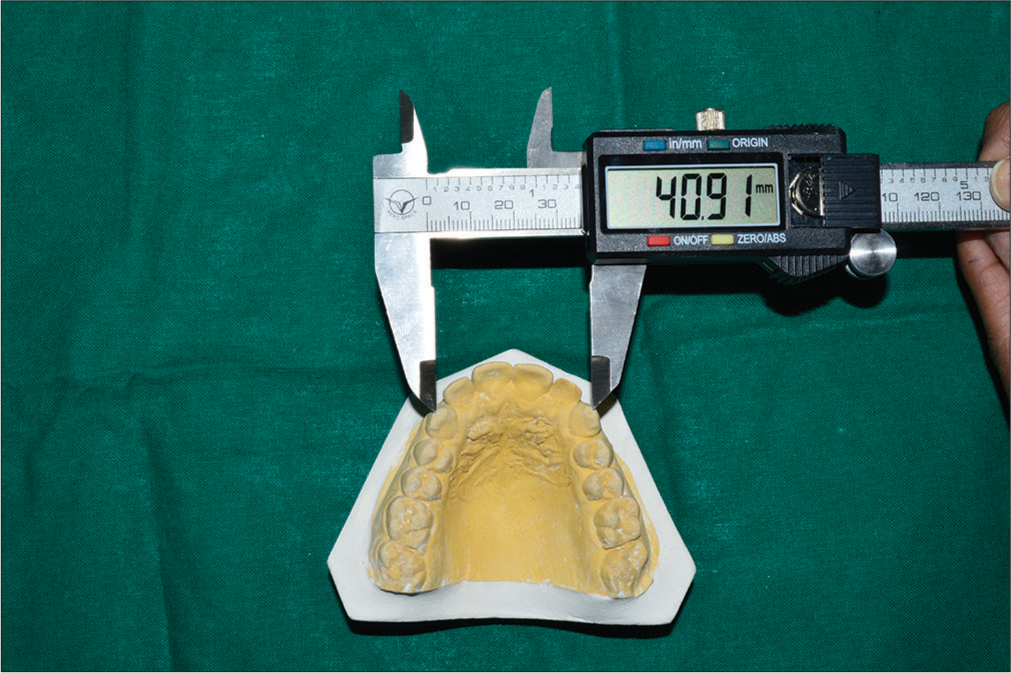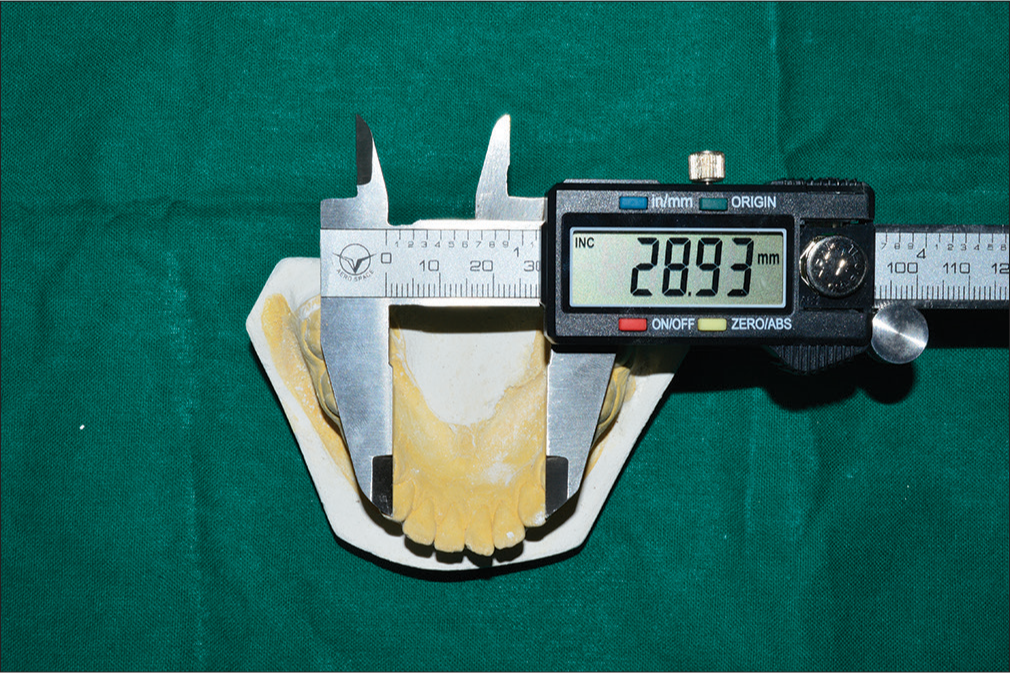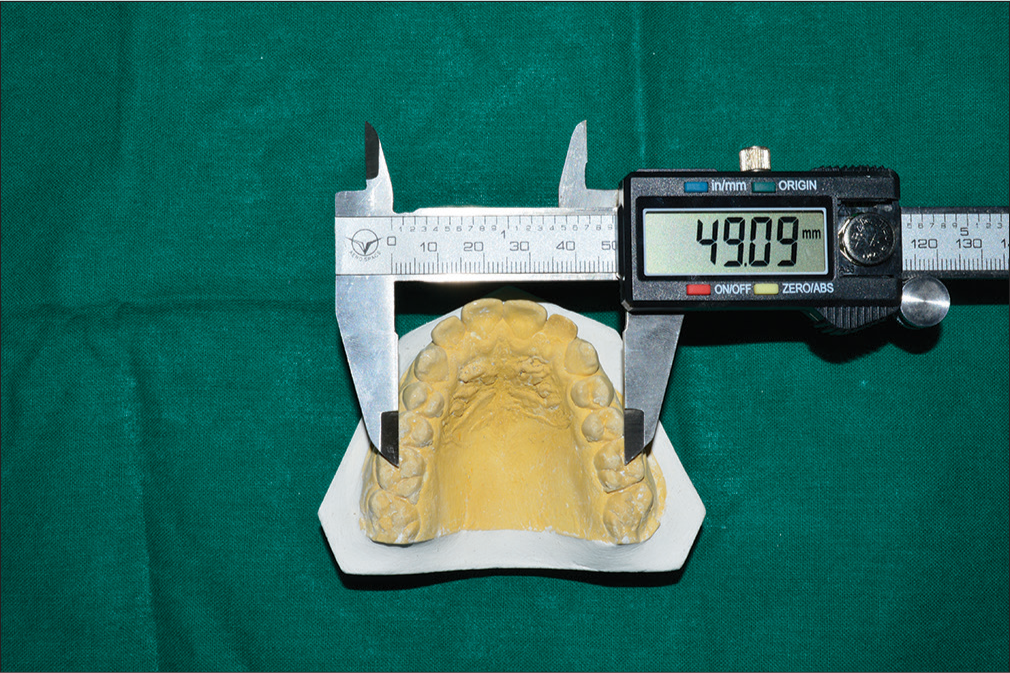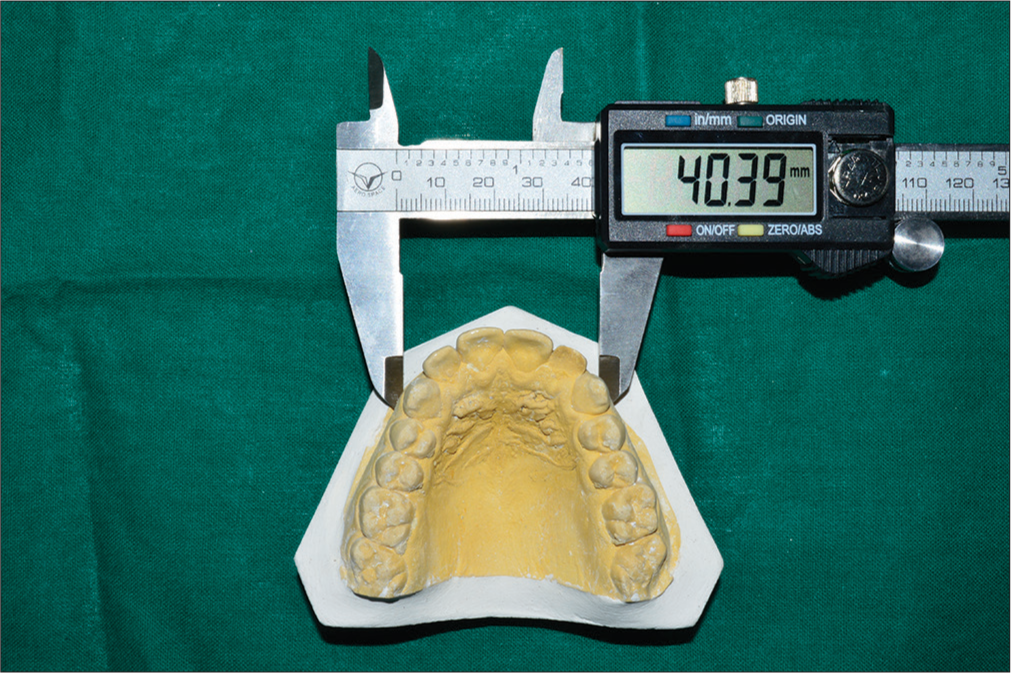Translate this page into:
Evaluation of intercanine arch width, intermolar arch width and the canine fossa width in the determination of gender of an individual between 18 and 35 years – An in vitro analytical retrospective study

*Corresponding author: Sakshi Sandeep Patil, Department of Orthodontics and Dentofacial Orthopaedics, MGV’s KBH Dental College and Hospital, Nashik, India. sakshispatil9@gmail.com
-
Received: ,
Accepted: ,
How to cite this article: Patil SS, Aher SD, Nehete AB, Gulve ND, Tambe MS, Shukla RM. Evaluation of intercanine arch width, intermolar arch width and the canine fossa width in the determination of gender of an individual between 18 and 35 years – An in vitro analytical retrospective study. J Academy Dent Educ 2023;9:18-23.
Abstract
Objective s:
The aim of this study is to verify and assess the usefulness of intercanine arch width, intermolar arch width, and canine fossa width in maxilla and intercanine and intermolar width in mandible for gender determination in the adult population. In medicolegal cases, estimation of gender using the skeletal remains of victims is imperative. The identity of an individual can be verified by examination of teeth and surrounding tissues from skeletal remains. Measurements from teeth and skull can help a Forensic Odontologist to identify deceased victims by age, gender, or race. The association of skeletal remains with gender gains utmost importance in cases of mass fatality such as earthquakes, tsunami, accidents, cyclones, and floods. If an individual is not in a condition to be identified, then they can be identified from the dentition or remains of dentition during any natural or manmade calamities. The benefit of determining gender in mass calamities is that accurately determined gender confines the number of missing individuals to one-half of the population in the majority cases. Many studies pertaining to maxillary arch widths have been performed yet the literature regarding mandibular arch widths remains scarce. Furthermore, in the literature, very few studies have been carried out to correlate canine fossa width and gender of an individual.
Material and Methods:
The study was carried out on a sample size of 120 study models, between 18 to and 35 years in department of orthodontics and dentofacial orthopedics and the samples had equal male and female distribution. A digital vernier caliper measured the intercanine arch width, intermolar arch width and canine fossa width and the parameters were measured by a single observer and statistical analysis was performed.
Results:
Intercanine arch width in maxillary arch was 36.38 ± 3.08 mm and 33.44 ± 2.72 mm for males and females correspondingly with P < 0.001 which is statistically highly significant. Intermolar arch width in maxillary arch was 47.81 ± 3.02 mm and 45.2 ± 2.64 mm for males and females correspondingly with P < 0.001 which is statistically highly significant. Canine fossa width in maxillary arch was 43.42 ± 2.58 mm and 40.36 ± 2.32 mm for males and females correspondingly with P < 0.001 which is statistically highly significant. Intercanine arch width in mandibular arch was 27.43 ± 2.96 mm and 26.2 ± 1.97 mm for males and females correspondingly with P < 0.05 which is statistically significant. Intermolar arch width in mandibular arch was 41.88 ± 3.47 mm and 39.89 ± 2.48 mm for males and females correspondingly with P < 0.001 which is statistically highly significant. After employing the receiver operating curve, to figure out specificity and sensitivity of the parameters, high specificity of 97%, with the best sensitivity of 78% was recorded for the maxillary canine fossa width.
Conclusion:
The results show that in cases of mass calamities, maxillary canine fossa width will prove to be useful tool in gender determination accurately after analyzing the dental remains of young missing adults with multiple missing teeth. This will further aid the forensic odontologist to determine identity of the missing individual.
Keywords
Forensic odontology
Gender determination
Intercanine width
Intermolar width
Canine fossa width
INTRODUCTION
In Latin, the word “Forensis” means “forum or court of law”” and study of teeth is referred to as “Odontology.” Forensic odontology is science that deals with application of dental evidence in investigations of age and gender estimation and bitemarks.[1]
In search for the identity of individual remains, odontological examination plays a key role.[1] Identification of deceased fatalities by age, gender, and race is performed by a forensic odontologist using remains of teeth and skull.[1] In cases of mass fatality such as earthquakes, floods, tsunami, cyclones, and skeletal remains can serve extremely important to determine age and gender.[1] Accurately determined gender can limit the number of missing individuals to one half of the population and help in easy identification of the affected individual.[2]
Justice administration to a large extent depends on forensics department including trained dentists as forensic odontologists since scope of forensic odontology is very vast and demanding in cases of crimes or mass fatalities.[1]
Use of dentition in gender determination has been explored and advocated due to its strength and resistance to various insults.[2] Tooth size standards based on odontometric findings can be used in age and gender estimation as dentition of an individual is as unique as the fingerprints of the individual.[2] Sexual dimorphism refers to those variations in dimension, physique, and exterior appearance between male and female that can be applied for individual identification.[2] Canines are highly valuable in particular, as they have greatest degree of sexual dimorphism.[3] Interdental arch width and arch length measurements by a forensic odontologist and their comparison with the standard values play a key role in gender determination.[1]
The aim of this study is to verify and assess the usefulness of intercanine width, intermolar arch width, and canine fossa width in maxilla and intercanine and intermolar width in mandible for gender determination in adult population.
Rationale
The need for studying factors responsible for determining the gender of a deceased individual is of utmost importance since ancient times. Fingerprints and odontometric measurements are distinctive to every individual and hence can be used for gender identification. Thus, if an individual is not in a condition to be identified, then he or she can be identified from the dentition or the remains of dentition during any natural or manmade calamities such as earthquake, floods, and wars.[1,4] Many studies pertaining to maxillary arch widths have been performed yet the literature regarding mandibular arch widths remains scarce. Furthermore, in the literature, very few studies have been carried out to correlate canine fossa width and gender of an individual. Therefore, this study is to analyze what role does the intercanine arch width, intermolar arch width, and the canine fossa width play in determination of gender of an individual.
Null hypothesis
There is no difference in canine fossa width, intercanine arch width, and intermolar arch width in males and females of age 18–35 years.
Alternate hypothesis
There is a difference in canine fossa width, intercanine width, and intermolar width in males and females of age 18–35 years.
MATERIAL AND METHODS
The study was performed in the department of orthodontics and dentofacial orthopedics. The sample size was of 120 maxillary and mandibular study models out of which 60 were male and 60 female between 18 and 35 years of age.
Inclusion criteria
The following criteria were included in the study:
Age between 18 to and 35 years
Good quality study models
Presence of two canine teeth and two molars in the upper jaw.
Absence of crowding
Absence of spacing.
Exclusion criteria
The following criteria were excluded from the study:
Partially erupted teeth.
Teeth with severe attrition.
Impacted canines
Broken teeth on study models
Malaligned canines or molars.
Study design: In vitro, cross-sectional, analytical, and retrospective study design.
Study setting: The study was conducted on study models available in the department.
Study population: One hundred and twenty study models with equal gender distribution (60 males and 60 females) that meet the inclusion criteria.
Sample size: 120
Single blinded study.
Materials
120 study models including 60 males and 60 females.
Digital vernier caliper. (Aerospace).
Methodology
This study was conducted using 120 maxillary and mandibular study models.
The intercanine and intermolar arch widths of maxillary and mandibular arches, and the canine fossa width in the maxillary arch were measured using a digital vernier caliper (Aerospace).
The arithmetic means of the widths were calculated for males and females.
The receiver operating characteristic curve, to figure out specificity and sensitivity of the parameters to accurately determine gender was utilized
To eliminate bias, a single observer performed the measurements. The observer was not aware of the gender of the individual’s model that they were measuring.
Patient consent
Not applicable as patient anonymity was maintained throughout the study.
Method of data analysis
Statistical analysis was performed using Statistical Package for the Social Science (SPSS) version 21 for Windows (SPSS Inc., Chicago, IL).
Descriptive quantitative data were expressed in mean and standard deviation, respectively. Shapiro–Wilk test was performed to determine data normality.
Confidence interval was at 95% and probability of alpha error (level of significance) set at 5%. Power of the study was set at 80%.
Intergroup gender-based assessment between both groups with respect to study parameters was done by unpaired t-test.
Diagnostic tests such as receiver operating characteristic ROC curve, sensitivity, and specificity were calculated to determine gender correctly using the above three parameters.
Operational definitions:
Intercanine arch width – The distance from the tip of cusp of one canine to the tip of cusp of the other canine in the same arch [Figures 1 and 2].
Intermolar arch width – The distance measured between the central fossa of molar on one side of arch to the central fossa of the molar on other side of the same arch [Figures 3 and 4].
Canine fossa width – Measurement of width from canine fossa (immediate depression distal to canine root eminence) of one side of maxillary arch to another side [Figure 5].
Digital vernier calliper – A precision instrument to measure an object’s dimensions accurately.

- Measurement of intercanine arch width in maxillary study model using digital vernier caliper.

- Measurement of intercanine arch width in mandibular study model using digital vernier caliper.

- Measurement of intermolar arch width in maxillary study model using digital vernier caliper.

- Measurement of intermolar arch width in mandibular study model using digital vernier caliper.

- Measurement of canine fossa width in maxillary study model using digital vernier caliper.
RESULTS
Intercanine arch width in maxillary arch was 36.38 ± 3.08 mm and 33.44 ± 2.72 mm for males and females correspondingly with P < 0.001 which is statistically highly significant. Intermolar arch width in maxillary arch was 47.81 ± 3.02 mm and 45.2 ± 2.64 mm for males and females correspondingly with P < 0.001 which is statistically highly significant. Canine fossa width in maxillary arch was 43.42 ± 2.58 mm and 40.36 ± 2.32 mm for males and females correspondingly with P < 0.001 which is statistically highly significant [Table 1]. Intercanine arch width in mandibular arch was 27.43 ± 2.96 mm and 26.2 ± 1.97 mm for males and females correspondingly with P < 0.05 which is statistically significant. Intermolar arch width in mandibular arch was 41.88 ± 3.47 mm and 39.89 ± 2.48 mm for males and females correspondingly with P < 0.001 which is statistically highly significant [Table 2]. After employing the receiver operating curve, to figure out specificity and sensitivity of the parameters, high specificity of 97%, with the best sensitivity of 78% was recorded for the maxillary canine fossa width [Table 3 and Graph].
| Maxillary | Males | Females | Unpaired t-test | P-value, Significance |
|---|---|---|---|---|
| Intercanine | 36.38 | 33.44) | t=5.531 | P<0.001** |
| width | (3.08) | (2.72) | ||
| Intermolar | 47.81 | 45.2 | t=5.046 | P<0.001** |
| width | (3.02) | (2.64) | ||
| Canine fossa | 43.42 (2.58) | 40.36 (2.32) | t=6.804 | P<0.001** |
| Mandibular | Males | Females | Unpaired t-test | P -value, Significance |
|---|---|---|---|---|
| Intercanine | 27.43 | 26.2 | t=2.695 | P=0.008* |
| width | (2.96) | (1.97) | ||
| Intermolar | 41.88 | 39.89 | t=3.614 | P<0.001** |
| width | (3.47) | (2.48) |
| Balanced (%) | High specificity (%) | |||
|---|---|---|---|---|
| Sensitivity | Specificity | Sensitivity | Specificity | |
| Maxilla | ||||
| Intercanine | 78 | 89 | 58 | 94 |
| width | ||||
| Intermolar | 83 | 82 | 74 | 95 |
| width | ||||
| Canine | 87 | 85 | 78 | 97 |
| fossa | ||||
| Mandible | ||||
| Intercanine | 69 | 79 | 63 | 87 |
| width | ||||
| Intermolar | 72 | 74 | 69 | 89 |
| width | ||||
DISCUSSION
Gender determination is very important in the identification of an individual affected in calamities. In recent times, there is a steep increase in natural as well as man made calamities such as accidents, earthquakes, floods, wars, and riots. The total number of missing or lost victims can be confined to only half of the missing population if gender is known.[1,2].
In the field of forensics, recovery of partial remains such as fragmented skull and/or jaws is very common. The teeth due to their strength are most commonly retrieved remains as they are resistant to a variety of antemortem and postmortem insults.[3,5-10] Intercanine arch width and intermolar arch width of maxilla have been used in gender determination in the past.[4,11-13] However, in this study, we have also included canine fossa width of maxilla and intercanine and intermolar widths of mandible which can be accurately employed in gender determination. The measurements of intercanine, intermolar, and canine fossa widths of maxilla showed a very high statistical significance (P < 0.001) in gender determination. The measurement of intermolar width in mandible also showed a very high statistical significance (P value < 0.001) in gender determination. The intercanine width in mandible showed a high significance in gender determination with P value = 0.008. On using the receiver operating curve to deduce sensitivity and specificity of the measurements taken, maxillary canine fossa width gave high specificity of 97%, with the best sensitivity of 78%. Thus, from this study, we can deduce that both maxillary and mandibular measurements can be helpful in gender determination in mass casualties by comparing them with normal odontometric standards.

- ROC: Receiver operating curve
CONCLUSION
Although the teeth measurements based on canines and molars have been useful and have been substantiated from ancient times for gender determination of individuals, the canine fossa width of maxilla in gender determination has not been considered.[14-18] Based on the results of this study, intercanine and intermolar widths of both maxilla and mandible can be used for gender determination due to its high statistical significance. Moreover, due to its high specificity and sensitivity, the maxillary canine fossa width will be useful in determining gender of dental remains more accurately of young adults with multiple missing teeth in maxilla and mandible in cases of mass casualties.
Limitations
Study will not be useful in cases of missing canine as canines are commonly impacted.
Study will not be useful in grossly carious molars or missing molars.
Study will not be useful in cases of fractured maxilla or mandible.
Declaration of patient consent
Patient’s consent not required as patient’s identity is not disclosed or compromised.
Conflicts of interest
There are no conflicts of interest.
Financial support and sponsorship
Nil.
References
- Comparison of intercanine and intermolar width of the maxilla as an aid in gender determination: A preliminary study. Drug Invent Today. 2018;3:3149-52.
- [Google Scholar]
- Sex determination by means of intercanine and intermolar width-a study in Telangana population. Asian Pac J Health Sci. 2016;3:171-5.
- [CrossRef] [Google Scholar]
- Limitations of the mandibular canine index in sex assessment. J Forensic Leg Med. 2009;16:67-9.
- [CrossRef] [PubMed] [Google Scholar]
- Intermolar width: A reliable tool in gender determination. SRM J of Dent Sci. 2019;10:197-99.
- [CrossRef] [Google Scholar]
- Changes in arch width. A 20-year longitudinal study of orthodontic treatment. Angle Orthod. 2006;76:6-13.
- [Google Scholar]
- Relationship between dental arch width and vertical facial morphology in untreated adults. Eur J Orthod. 2008;30:288-94.
- [CrossRef] [PubMed] [Google Scholar]
- Prediction of arch length based on intercanine width. Eur J Orthod. 2008;30:295-8.
- [CrossRef] [PubMed] [Google Scholar]
- Validity of the mandibular canine index (MCI) in sex prediction: Reassessment in an Indian sample. Forensic Sci Int. 2011;204:207.e1-4.
- [CrossRef] [PubMed] [Google Scholar]
- Dimorphism in human maxillary and mandibular canines in establishment of gender. J Forensic Dent Sci. 2009;1:42-4.
- [CrossRef] [Google Scholar]
- Variations in tooth size and arch dimensions in Malay school children. Aust Orthod J. 2009;25:163-8.
- [Google Scholar]
- Progressive changes in arch width from primary to early mixed dentition period: A longitudinal study. J Indian Soc Pedod Prev Dent. 2011;29:14-9.
- [CrossRef] [PubMed] [Google Scholar]
- Dental arch width in children and relationship to their oral habits. Bang J Orthod Dentofac Orthop. 2017;7:6-11.
- [CrossRef] [Google Scholar]
- Estimation of the intercanine width, intermolar width, arch length, and arch perimeter and its comparison in 12-17-year-old children of Faridabad. Int J Clin Pediatr Dent. 2021;14:369-75.
- [CrossRef] [PubMed] [Google Scholar]
- Relationship among intercanine width, intermolar width and arch length in upper and lower arch for dentistry students in Thi-Qar University. J Res Med Dent Sci. 2021;9:126-30.
- [Google Scholar]
- Prediction of arch perimeter based on arch width as a guide for diagnosis and treatment planning. Bull Natl Res Cent. 2021;45:141.
- [CrossRef] [Google Scholar]
- Wheeler's Dental Anatomy, Physiology and Occlusion. Vol 23. (8th ed). New Delhi: Elsevier; 2003. p. :53.
- [Google Scholar]
- Stature prediction by comparing maxillary and mandibular intercanine width and intermolar width among Tamil Nadu population. J Pharm Bioallied Sci. 2022;14(Suppl 1):S706-11.
- [CrossRef] [PubMed] [Google Scholar]
- Evaluation of sexual dimorphism using mesiodistal dimensions of permanent maxillary central incisors, canines and maxillary intermolar width in davanagere children-an odontometric study. J For Dent Sci. 2020;12:174-81.
- [Google Scholar]






